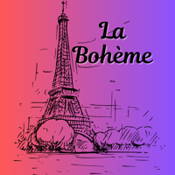
Overview
Synopsis
A group of friends are living a bohemian life in Paris and trying to make their livings creating art. Rodolfo, the writer, falls in love with the seamstress, Mimi, while Marcello, the painter, and Musetta, the singer, are the on-and-off-again couple by their sides. When the four are happy, they spend their time celebrating life and love. However, Mimi is revealed to be very ill, and Rodolfo struggles to come to terms with the fact that she will inevitably die. Rodolfo and Mimi break up, and months later, Musetta discovers Mimi extremely sick and close to death. She brings Mimi to Rodolfo and Marcello's apartment. Rodolfo immediately takes her in and tries to nurse her back to health, but he is too late. Almost as soon as the two are reunited and have professed their love for one another, Mimi succumbs to her illness and dies.
Show Information
Context
La Bohème is based on the novel Scenes de la vie de boheme, a collection of short stories which describes the life of young bohemians living in Paris in the 1840s, written by Henry Murger. Illica and Giacosa formed the opera, like the play, around the relationship between Mimi and Rodolfo. Interestingly, in the original play, there are two women, Mimi and Francine, whose personalities and journeys through the play are combined to form the Mimi that we know in the opera. Illica and
to read the context for La Bohème and to unlock other amazing theatre resources!Plot
Act I The Bohemian’s Garrett (Rodolfo, Marcello, Colline, Schaunard, Benoit, Mimì
Act II The Latin Quarter (Chorus, Rodolfo, Mimì, Colline, Schaunard, Marcello, Parpignol, Musetta, Alcindoro)
Act III At the Toll Gate at the Barrière d’Enfer (Mimì, Rodolfo, Marcello, Musetta)
Act IV The garrett (Marcello, Rodolfo, Colline, Schaunard, Musetta, Mimì)
Act I
Freezing in their apartment, Marcello and Rodolfo burn the manuscript of Rodolfo’s play to stay warm. Colline, their
to read the plot for La Bohème and to unlock other amazing theatre resources!Characters
| Name | Part Size | Gender | Vocal Part |
|---|---|---|---|
|
Lead |
Female |
Soprano |
|
|
Lead |
Male |
Baritone |
|
|
Lead |
Female |
Soprano |
|
|
Lead |
Male |
Tenor |
|
|
Supporting |
Male |
Baritone |
|
|
Supporting |
Male |
Bass |
|
|
Supporting |
Male |
Bass |
|
|
Featured |
Male |
Bass |
|
|
Featured |
Male |
Tenor |
|
|
Ensemble |
Male |
Bass |
Songs
Act I The Bohemian’s Garrett (Rodolfo, Marcello, Colline, Schaunard, Benoit, Mimì)
- Scena e Duetto (Marcello, Rodolfo)
- Scena (Marcello, Rodolfo, Colline, Schaunard)
- Scena (Marcello, Rodolfo, Colline, Schaunard, Benoit)
- Scena e Duetto: -Chi è la!? -Scusi. -Una donna! ...(Rodolfo, Mimì)
- Aria: Che gelida manina (Rodolfo)
- Aria: Sì. Mi chiamano Mimì (Mimì)
- Duetto: Ah! Tu sol comandi, amor! (Rodolfo, Mimì)
Act II The Latin Quarter (Chorus, Rodolfo, Mimì, Colline, Schaunard, Marcello, Parpignol, Musetta, Alcindoro)
- Coro: Aranci! Datteri! (Chorus)
- Scena: Falso questo Re! (Schaunard, Mimì, Rodolfo, Colline, Marcello, Chorus)
- Coro: Parpignol! (Chorus, Parpignol, Marcello, Schaunard, Colline, Rodolfo, Mimì)
- Scena: Ch’io beva del tossico!..(Marcello, Musetta, Alcinodoro, Chorus, Mimì, Rodolfo, Colline, Schaunard)
- Aria: Quando m’en vo’ (Musetta)
- Scena: Quella gente che dira. (Rodolfo, Schaunard, Colline, Musetta, Mimì, Alcindoro, Marcello)
- Coro: Ecco il tambur maggiore! (Chorus, Mimì, Musetta, Rodolfo, Marcello, Colline, Schaunard)
Act III At the Toll Gate at the Barrière d’Enfer (Mimì, Rodolfo, Marcello, Musetta)
- Coro: Chi nel bel trovà il piacer (Coro, Guard, Musetta, Sergeant)
- Duetto: -Mimì -Speravo di trovarvi qui (Mimì, Marcello)
- Duetto: Marcello. Finalmente! (Rodolfo, Marcello)
- Trio: -Mimì!? -Che vuol dire? (Rodolfo, Marcello, Mimì)
- Aria: Donde lieta (Mimì)
- Quartetto: Addio dolce svegliare (Mimì, Rodolfo, Musetta, Marcello)
Act IV The garrett (Marcello, Rodolfo, Colline, Schaunard, Musetta, Mimì)
- Duetto: O Mimì tu più non torni (Marcello, Rodolfo)
- Scena: Eccoci! (Marcello, Rodolfo, Colline, Schaunard)
- Scena: -Musetta! - C’è Mimì (Marcello, Musetta, Rodolfo, Schaunard, Mimì, Colline)
- Aria: Vecchia zimarra (Colline)
- Duetto: Sono andati? (Mimì, Rodolfo)
- Scena: Che ha detto il medico? (Rodolfo, Musetta, Marcello, Schaunard, Colline)
A song with an asterisk (*) before the title indicates a dance number; a character listed in a song with an asterisk (*) by the character's name indicates that the character exclusively serves as a dancer in this song, which is sung by other characters.
Monologues
Scenes
Key Terms
Describes characters or artists who reject conventional norms, often romanticized in theatre and musicals.
Videos
Quizzes
Themes, Symbols & Motifs
Sorry! We do not currently have learning modules for this guide.
Quote Analysis
Sorry! We do not currently have learning modules for this guide.
